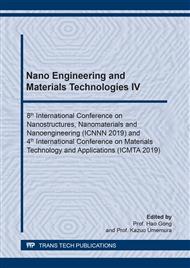p.61
p.67
p.73
p.81
p.86
p.91
p.96
p.101
p.106
Preparation of Crude Turmeric Extract Loaded Poly(Acrylamide-co-Acrylic Acid) Microspheres for Drug Release System
Abstract:
Crude turmeric extract (CTE), which is a natural substance, is obtained from Curcuma Longa L. This substance is widely used in pharmaceutical application because of its ability to treat various diseases. Dermatitis is one of the many diseases that can be treated by CTE due to their inhibition of gram-negative and gram-positive bacteria. CTE has short half-life and easy to degradation. Therefore, protection has to be applied on CTE to prevent from decomposition before applying to skin. This research mainly focuses on preparation of CTE loaded poly (acrylamide-co-acrylic acid) (PAMAA) hydrogel microspheres (HM) at 9:1, 8:2 and 7:3 mole ratios and investigation of the releasing profile of CTE from microsphere. The particle size distribution of PAMAA microsphere that is analyzed by SEM found that mole ratios of PAMAA with 9:1, 8:2 and 7:3 showed the narrow particle distribution with average particle size at 28.1±7.4, 25.5±6.6 and 23.2±5.5 respectively. Thermal decomposition property of PAMAA is confirmed by TGA and HM swelling ratios are confirmed by weight indicated that the percentage swelling ratios of PAMAA with 9:1, 8:2 and 7:3 mole ratios is 1500, 1230 and 780 respectively. CTE releasing profiles are confirmed by UV-Vis in the media solutions of PBS pH 8.5 and NaOH pH 12.
Info:
Periodical:
Pages:
86-90
Citation:
Online since:
May 2020
Keywords:
Price:
Сopyright:
© 2020 Trans Tech Publications Ltd. All Rights Reserved
Share:
Citation:


